Introduction, Extent & Political History: The Sangam Age | History for UPSC CSE PDF Download
The Sangam Age
Tamil literature has a long and continuous history spanning over twenty centuries. The earliest phase of this literature is known as the Sangam literature. This period is characterized by anthologies of odes, lyrics, and idylls composed when the Pandyan kings of Madurai maintained a group of eminent poets at their court. These poets functioned as unofficial literary censors, ensuring the quality and standards of literary works.
Later poets and scholars, such as saint Navukharasarand the commentator on the Iraiyanar Ahapporul, used the term"Sangam"to refer to this association of scholars and poets.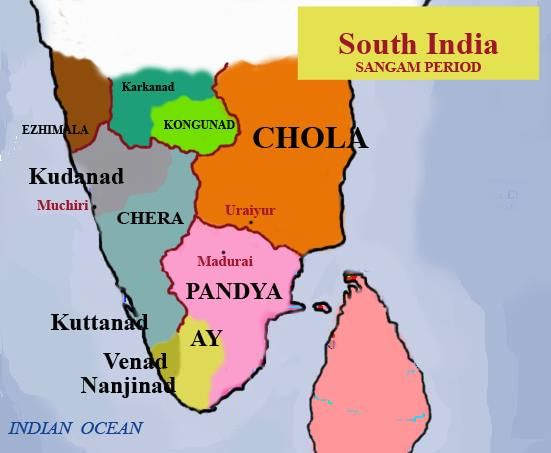
Sangam Period
- While it is challenging to accept all the legendary details about the Sangam period provided by later writers as authentic history, it is equally difficult to deny the existence of an institution like the Sangam.
- The preface to the Tolkappiyam mentions the practice of court poets critically examining learned treatises, indicating the presence of a scholarly and literary tradition.
- A significant portion of the literature produced during the Sangam period has been lost over time.
- Legendary accounts suggest that many texts were lost due to a 'deluge' that forced the Pandyan kings to relocate their capital from Ten-Madurai to Kapatapuram and then to Madurai.
- The literature that currently exists from the Sangam period is just a fraction of the vast body of work that once existed.
Extent
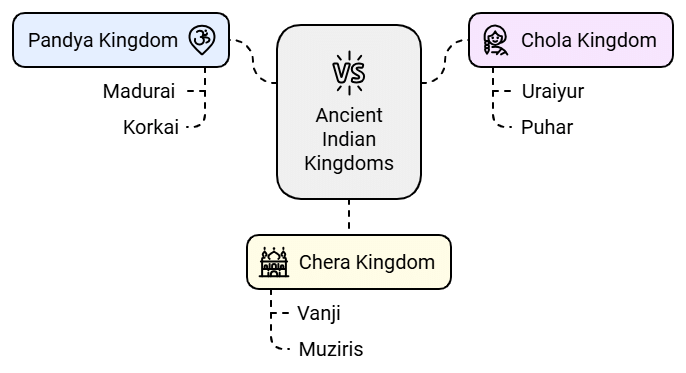
Pandya Kingdom:
- Located in the extreme south of India, covering modern districts of Madurai, Ramnad, and Tirunelveli.
- Capital was Madurai, with earlier capitals being Ten-Madurai and Kapatapuram.
- Main seaport was Korkai, with another seaport at Saliyur.
Chola Kingdom:
- Comprised the lower Kaveri Valley, roughly corresponding to modern Tanjore and Tiruchirapalli districts.
- Inland capital was Uraiyur, later known as Puhar.
Chera (Kerala) Kingdom:
- Covered the western coastal strip above the northern limit of the Pandyan kingdom.
- Capital was Vanji or Karur.
- Best-known ports included Tondi and Muziris.
Political History
- The political system during the Sangam period was characterized by several small kingdoms, each ruled by a king.
- The Chera, Chola, and Pandya kingdoms were the most significant powers during this time.
- The kings held absolute power and were considered divine rulers.
- Their main responsibilities included ensuring the security of their people, resolving disputes, and administering justice.
- The kings belonged to the Kshatriya warrior clan.
- The kingdoms varied in size, with major kingdoms like the Cheras, Cholas, and Pandyas ruling large parts of Tamil Nadu.
- There were also many smaller kingdoms ruled by subordinate kings who pledged allegiance to the larger kingdoms.
- These kingdoms were often engaged in warfare with one another.
Ministers and Officials
- The king was assisted by a council of ministers responsible for advising him and helping with the administration. Key ministers included the prime minister (Mantri), treasurer, and army officials (Senapati). The king appointed these officials and was accountable for ensuring they performed their duties effectively.
- The council of ministers played a crucial role in maintaining stability in the kingdom by guiding the king and overseeing various administrative functions.
Assembly and Public Participation
- An assembly called the sabha advised the king on important administrative and political matters.
- This assembly consisted of ministers, officials, and elders.
- While the public could participate in electing kings and village assemblies, only men from the upper castes were allowed to participate in the assemblies.
Social Classes
- Society during the Sangam period was divided into different varnas: Brahmins, Kshatriyas, Vaishyas, and Shudras.
- The Brahmins, who were priests and scholars, held the highest position in society.
- They were followed by the Kshatriyas, who were warriors and kings.
- The Vaishyas consisted of farmers, traders, and artisans, while the Shudras performed menial jobs.
- Slaves occupied the lowest position in the social hierarchy.
- These divisions determined the status and responsibilities of various sections of society.
Land and Taxes
- Agriculture was the primary occupation during the Sangam age, and land was the main source of wealth.
- The king owned most of the land and distributed it among his subordinates, who in turn paid taxes to the king.
- Various types of taxes were levied, including a fixed share of agricultural produce, taxes on trades and professions, and special cesses.
- The revenue from these taxes primarily supported the royal court and the military.
Army and Warfare
- Kings kept a strong army to defend and grow their lands.
- The army included different types of soldiers such as infantry, cavalry, and units with chariots and elephants.
- During this time, battles were fought using basic weapons like swords, shields, spears, bows, and arrows.
Chola Dynasty
The Chola dynasty was one of the Tamil dynasties in southern India and at its height, it ruled over an expansive maritime empire known as the Chola Empire.

The Chola Empire became a significant power under the Medieval Cholas in the mid-9th century CE.
The dynasty was one of the Three Crowned Kings of Tamilakam, along with the Chera and Pandya, and continued to govern varying territories until the 13th century CE.
Heartland and Expansion. The Cholas' heartland was the fertile valley of the Kaveri River. During their peak from the late 9th century to the early 13th century, they unified peninsular India south of the Tungabhadra River and maintained this territory as a single state for three centuries, specifically between 907 and 1215 CE.
Notable Rulers. Under the leadership of Rajaraja I and his successors, including Rajendra I, Rajadhiraja I, Rajendra II, Virarajendra, and Kulothunga Chola I, the Chola Empire became a military, economic, and cultural powerhouse in South Asia and Southeast Asia.
Maritime Power. The Cholas were known for their impressive maritime capabilities. Their naval strength was evident in expeditions to the Ganges, raids on the Srivijaya empire in Sumatra, and diplomatic missions to China. The Chola fleet represented the peak of ancient Indian maritime capacity.
Decline. Around 1070 CE, the Cholas began to lose most of their overseas territories, but the later Cholas (1070–1279 CE) continued to rule parts of Southern India. The Chola Empire started to decline in the early 13th century with the rise of the Pandyan dynasty, which eventually led to the Cholas' downfall.
Sources of Information:There is limited written evidence regarding the Cholas before the 7th century CE.
Periods of Chola History
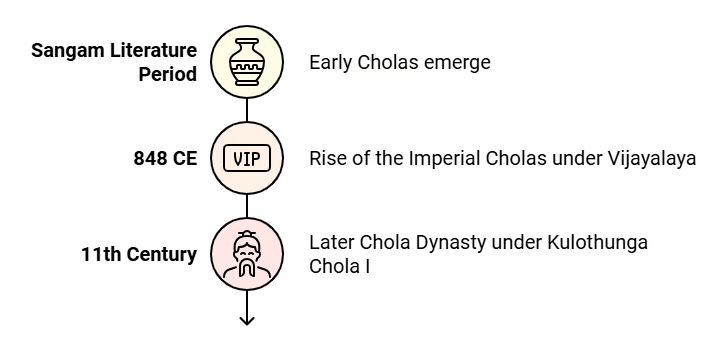
- Early Cholas: Refers to the period described in Sangam literature.
- Interregnum: The time between the decline of the Sangam Cholas and the emergence of the Imperial medieval Cholas under Vijayalaya around 848 CE.
- Dynasty of Vijayalaya: The period of the Chola dynasty under Vijayalaya.
- Later Chola Dynasty: The era of Kulothunga Chola I, starting from the third quarter of the 11th century.
Chola: Polity and Administration
- The administration under the Cholas was highly efficient and well-organized.
- At the top of the hierarchy was the emperor or king. The king is typically referred to as Ko (king) or Perumal Adigalin Chola inscriptions (the great one).
- The Chola throne was hereditary, following the principle that the eldest son of the king should succeed to the throne. The heir apparent was known as Yuvaraja.
- The early Chola kings’ titles were initially modest but later transformed into grandiose ones, reflecting their status as rulers, such as Raja-Rajadhiraja and Ko-Konmai-Kondan, meaning “king of kings.”
- Inscriptions depict the king as a great warrior, a defender of Varnadharma, a slayer of the evils of the Kali Age, a generous giver of gifts, and a patron of the arts. He was also described as physically appealing, often compared to the gods.
- The king was supported by an army of officers or a council of ministers known as Udankuttam. The Raja Guru, the royal family priest, played a crucial role as the king’s temporal and spiritual advisor.
- The Cholas had a sophisticated and intricate administrative structure with officials of various ranks. Higher officials held the status of Perundanam, while lower officials were known as Sirudaramby. Officers were rewarded with titles and land assignments. The tiger was the royal emblem of Chola kings.
- Provincial Government:The Chola empire was divided into principalities under Vassal Chiefs and Mandalams (provinces) under Viceroys, typically royal princes. Further divisions included Valanadus, Nadus, and Villages for administrative convenience.
Chola Administration
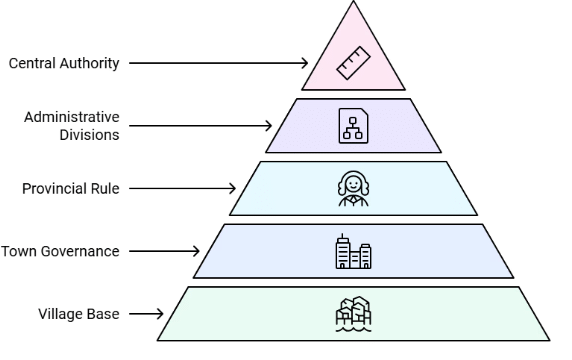 1. Local Administration:
1. Local Administration:
(a) Village: The village was the basic unit of administration.
(b) Town: Towns had their own independent administration, governed by a council called the Nagarattar. Towns were known as Nagaram.
2. Provinces: The Chola Empire was divided into nine provinces, known as mandalams. Each province was ruled by a viceroy, who was a close relative of the king.
3. Viceroys: The viceroys were in constant contact with the central government and were responsible for carrying out the king’s orders. They were assisted by a large number of officials in their administrative duties.
4. Sabhas and Assemblies: The Chola polity was notable for the existence of Sabhas and Assemblies that oversaw the administration of territorial divisions. There were various assemblies in different units, such as Nadu, Kurram, and Grama.
5. Administrative Divisions: The success of the Chola administration depended on the smooth operation of its administrative divisions. Mandalams were often named after the original names or titles of Chola kings. Each mandalam was subdivided into Kottams or Valanadus, which were further divided into nadu, and then into villages (Urs).
6. Village Administration: The villages were self-sufficient and had a high level of autonomy. The villagers were responsible for running the village themselves, and a village assembly was established to oversee this.
7. Types of Village Assemblies: There were three different types of village assemblies:
(a) Ur: An assembly made up of all socioeconomic groups in the community.
(b) Sabha:. Brahmin assembly found only in the agrahara or Chaturvedimangalam of Nagaram villages.
(c) Nagaram:. gathering of business people, primarily found in trade centres.
Village Administration During the Chola Period
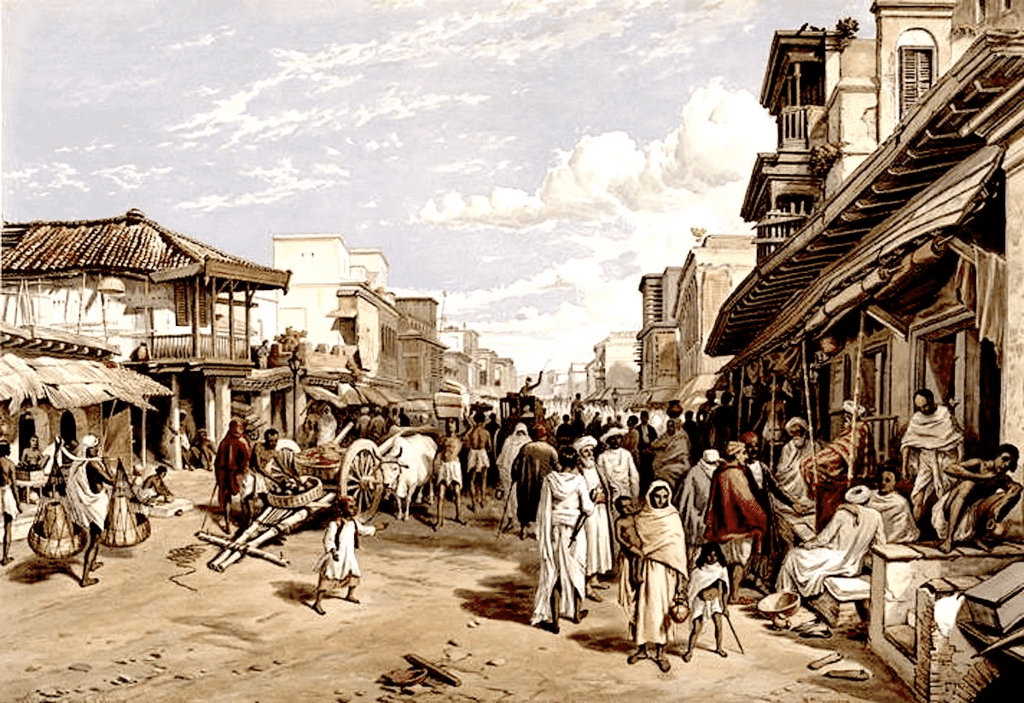
Ur and Sabha:
- The presence of both the Ur and Sabha in the same village indicates that non-Brahmins, or the Ur, who owned land, were the original villagers in charge.
- The Brahmins were later given control of these villages as an agrahara.
- Role of Assemblies: These assemblies were the main legislative bodies of the localities, overseeing all shared issues.
- They were supported by various committees responsible for different activity spheres.
Uttaramerur Inscriptions:
- The primary source for reconstructing village administration during the Chola period is the Uttaramerur inscriptions. These were written by Chola monarch Parantaka I between 919 and 921 CE and found in the Vaikunta Perumal temple at Uttaramerur, Chengalput district, Tamil Nadu.
- Purpose of Inscriptions: The inscriptions aimed to improve village administration by establishing new guidelines for committees. They were issued to combat the disorganization caused by dishonest individuals infiltrating these committees.
- Committee Guidelines: The inscriptions provide detailed information on committee composition, membership requirements, and the selection process for committee members.
- Changes in Procedures: The second inscription, issued two years after the first, modified the selection procedures to address operational issues encountered by the committees.
Selection Criteria (921 CE): To nominate candidates from each of the village’s thirty wards, the following criteria were established:
- Ownership of more than one-fourth Veli (approximately one and a half acres) of land
- Residency in a house built on one’s own land
- Age between 35 and 70
- Understanding of Vedic literature
Ineligibility Criteria: The following individuals were deemed ineligible:
- Those who had served on any committee in the previous three years
- Those who had served on a committee but failed to submit financial reports along with their relatives’ reports
- Those who had committed serious sins, such as adultery, along with their relatives
- Those who had stolen someone else’s property
Selection Process: Candidates were to be chosen from the nominations for each of the thirty wards by Kudavolai (pot ticket) or lot for a year, following the specified manner.
Village Assemblies and Administration in the Chola Period

- The Variyaperumakkal was the name of the committee, Perunguri was the name of the Mahasabha, and Perumakkal was the name of the members.
- The village assembly typically gathered in the village temple, but it could also meet outside or by the tank’s banks. Neither the royal nor central authority had influence over these assemblies. However, central government officers attended when important matters, such as changes in constitutional procedures or land rights affecting the king’s revenues, were discussed. Their role was more of advisors and overseers rather than administrators.
- The Uttaramerur inscriptions indicate that village committee members were not entitled to a salary or any form of payment for their services. The position was honorary, and no committee member was expected to dedicate more than a portion of their time and effort to it. The individuals in charge of village assemblies and committees were expected to uphold the principles of sacrifice, duty, and the welfare of the village community.
Sovereign Rights of Village Assemblies
- Village assemblies had the authority to levy and remit taxes for village purposes.
- They could seize land from individuals who failed to pay land taxes.
- Assemblies resolved local disputes and determined the guilt or innocence of parties involved, although punishments were imposed by royal officials.
- They were responsible for charitable activities.
Role of Variyams in Village Administration
- Village Assemblies effectively managed administration with the help of variyams, consisting of male members of society.
- The composition, qualifications, and durations of membership of these variyams varied from village to village.
- Every village had multiple variyams with specific responsibilities.
- Thottavariyam looked after flower gardens.
- Niyaya Variyam administered justice.
- Dharma Variyam was in charge of charities and temples.
- Erivariyam managed water tanks and supply.
- Pon Variyam overseen finance.
- Gramakariya Variyam supervised the work of all committees.
Members of these variams were known as “Varivaperumakkal” and performed honorable service. Village officials were compensated either in cash or kind. The effectiveness of these variams contributed to the efficiency of Chola local administration.
Chera Dynasty
- The Chera Dynasty, also known as the Cheras, ruled over parts of present-day Kerala during the Sangam period.
- Their capital was Vanji, and they had important seaports at Tondi and Musiri.
- The emblem of the Cheras was the "Bow and Arrow."
- The Chera kings were referred to as " Keralaputas," meaning "sons of Kerala."
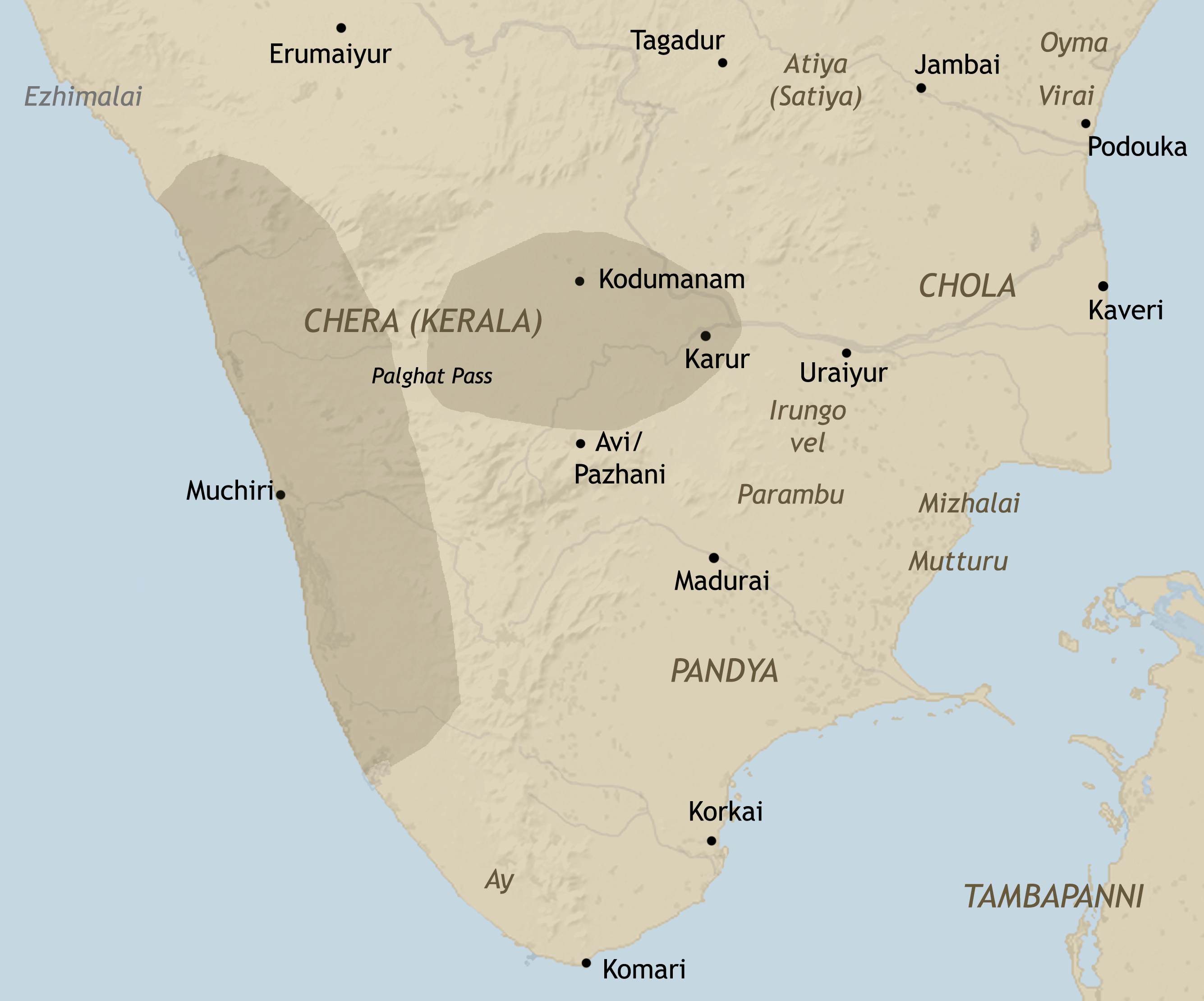
Early Rulers
- Uthiyan Cheralathan is the earliest known ruler of the Chera Dynasty. His base of power was in Kuzhumur, located in Kuttanad, Kerala.
- Kulasekhara Alwar is considered the first king of the later Chera kingdom, which eventually evolved into the Kulasekhara dynasty.
Kulasekhara Alwar
- After a period of over five centuries without any record of a Chera monarch, Kulasekhara Alwar emerged, claiming descent from the Chera dynasty.
- He likely ruled around 800 AD from Tiruvanchikkulam in present-day Kerala and had a reign lasting over 20 years.
Later Rulers
- The throne was later held by Ramavarma, also known as Kulasekhara Perumal or Kulasekhara Koyiladhikarikal.
- His reign was marked by political turmoil and insecurity, making him the last ruler of the Later Chera dynasty.
Pugalur Inscription
- The Pugalur inscription from the first century A.D. mentions three generations of Chera rulers: Perum Sorru Udhiyan Cheralathan, Imayavaramban Nedum Cheralathan, and Cheran Senguttuvan.
- Cheran Senguttuvan, belonging to the 2nd Century AD, is renowned for his military achievements, including an expedition to the Himalayas where he defeated several North Indian monarchs.
- He also introduced the Pattini cult, which involved the worship of Kannagi as the ideal wife in Tamil Nadu.
Decline and Sources of Information
- After the 2nd Century AD, the power of the Cheras declined, and there is limited knowledge about their history until the 8th Century AD.
- Most of what is known about the Cheras today comes from Sangam Literature, with common sources including the Pathitrupattu, Akananuru, and Purananuru.
Polity and Administration of Cheras
- The king was the most important and powerful person in this empire. But still his power was constrained by the presence of council of ministers and learned persons of his court.
- The King held daily durbar to hear the problems of the common men and to redress them on the spot.
- The next important institution was known as manram which functioned in each village of the Chera kingdom.
- Its meetings were usually held by the village elders under a banyan tree and they helped in the local settlement of disputes. The Manrams were the venues for the village festivals as well.
- In the course of the imperial expansion of the Cheras the members of the royal family set up residence at several places of the kingdom (at Vanchi, Karur and Tondi). They followed the collateral system of succession according to which the eldest member of the family, wherever he lived, ascended the throne. Junior princes and heir-apparents (crown princes) helped the ruling king in the administration.
Pandya Kingdom
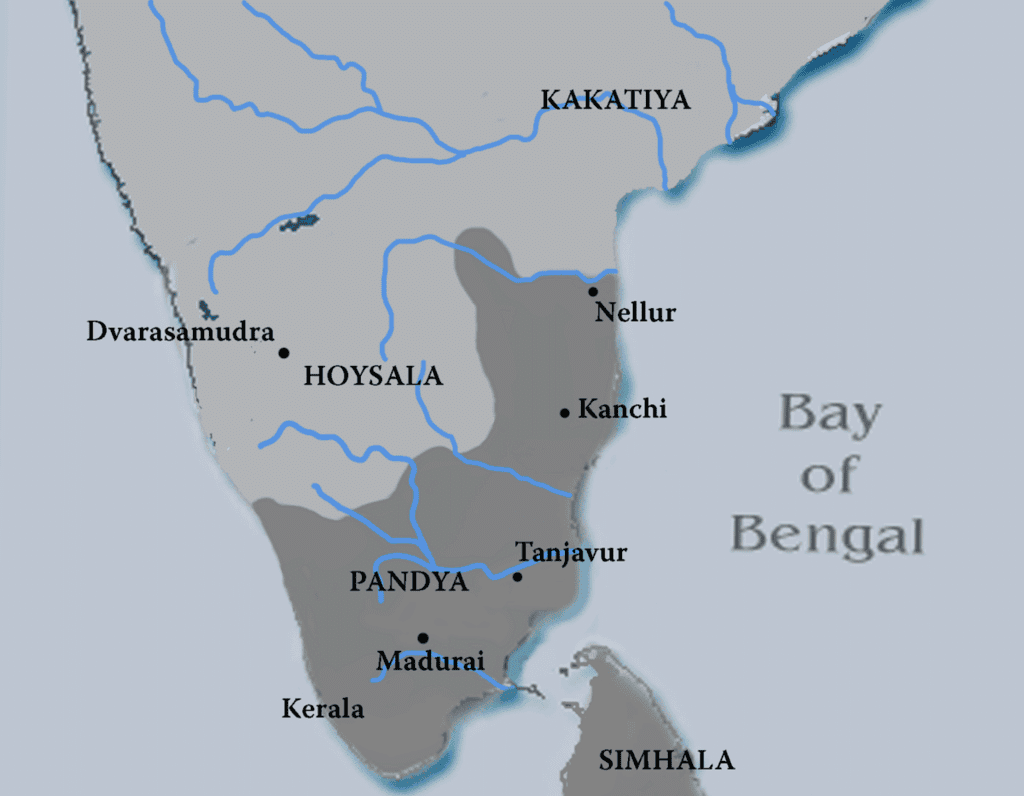
- The Pandya Kingdom, the Madurai Pandyas, was a historic Tamil dynasty in South India.
- It was a prehistoric Tamil nation in what is now South India.
- The Pandya dynasty time-period was from the 12th to 14th century CE.
- The Pandyas were one of three ancient Tamil dynasties that reigned intermittently in southern India since the 4th century BCE.
- The Pandyas were one of the three ancient Tamil kingdoms that controlled the Tamil nation from prehistoric times to the end of the 15th century.
- Initially ruling from the seaport of Korkai, which is located on the southernmost tip of the Indian peninsula, they subsequently relocated to Madurai.
Origin of the Pandya Dynasty
- The name "Pandya," which the early Tamils considered to be a symbol of manhood, power, and courage, comes from the Tamil term "Pandi," which means "the bull."
- It is also claimed that the early Pandyas supported the winning Pandavas in the battle of Kurukshetra.
- The Greeks, Chinese, Ptolemaic Egyptians, the Roman Republic, and the Empire were all allies of the Pandyas diplomatically.
- The Pandya Kingdom coexisted with other dynasties like the Cholas, Cheras, Pallavas, etc., in the southern Indian regions now part of Tamil Nadu.
- Up to their resurgence in the sixth century AD, the Kalabhras had driven the early Pandyas into oblivion.
- In the ninth century, the Cholas defeated them again, but in the twelfth century, they once more rose to power.
Administration of the Pandya Dynasty
The Pandya kingdom was organized into provinces, with each province governed by a viceroy.
The responsibilities of the viceroys included:
- Collecting taxes
- Maintaining law and order
- Administering the province
At the same time, the Pandyas had a central government led by the king. The king was supported by a council of ministers who provided advice on various state matters.
The bureaucracy in the Pandya dynasty was well-organized and tasked with executing the orders of the king and the council of ministers. Additionally, the Pandyas maintained a strong military to protect the kingdom from external threats.
Social and Political Aspects of the Pandya Kingdom
During the Pandya rule, society was traditionally divided into four groups: Brahmins, Kshatriyas, Vaisyas, and Sudras. However, there were other communities based on occupations, like Vellala, Ayar, and Idaiyar. The caste system was not strict, and people were often identified by their profession rather than their caste. Despite existing caste differences and political disorder, the people felt a sense of unity during the Pandyan era.
Clothing and Literature
- The wealthy wore silk clothing, while the average person wore cotton. Rich individuals adorned themselves with gems and accessories.
- The Pandyan Kings had a strong interest in Tamil culture, with Madurai, the capital, being a center for Tamil literature. Notable Tamil poetry was composed by Vaishnavaite saints in praise of Lord Vishnu.
Education and Women’s Status
- The Pandyan kings promoted education, with temples and mutts playing a crucial role. Land and resources were granted to enhance literacy and education.
- Women in the Pandyan empire were generally treated as equals to men, with the right to own property and participate in public events. Royal women had better educational opportunities. The famous Vaishnavite Alwar, Andal, lived during this time and gained fame.
Conclusion
The Sangam Age was characterized by strong monarchies under the Cholas, Cheras, and Pandyas, along with local governance through village assemblies. Kings focused on justice, military strength, and cultural support. The period set the stage for South India’s political and cultural future, promoting trade, agriculture, and Tamil literature.
|
226 videos|855 docs|219 tests
|
FAQs on Introduction, Extent & Political History: The Sangam Age - History for UPSC CSE
| 1. What was the extent of the Sangam Age in terms of geography and culture? |  |
| 2. What were the key political developments during the Sangam Age? |  |
| 3. How did the Chola dynasty manage its polity and administration during the Sangam Age? |  |
| 4. What were the administrative features of the Chera dynasty during the Sangam Age? |  |
| 5. What were the social and political aspects of the Pandya kingdom during the Sangam Age? |  |






















